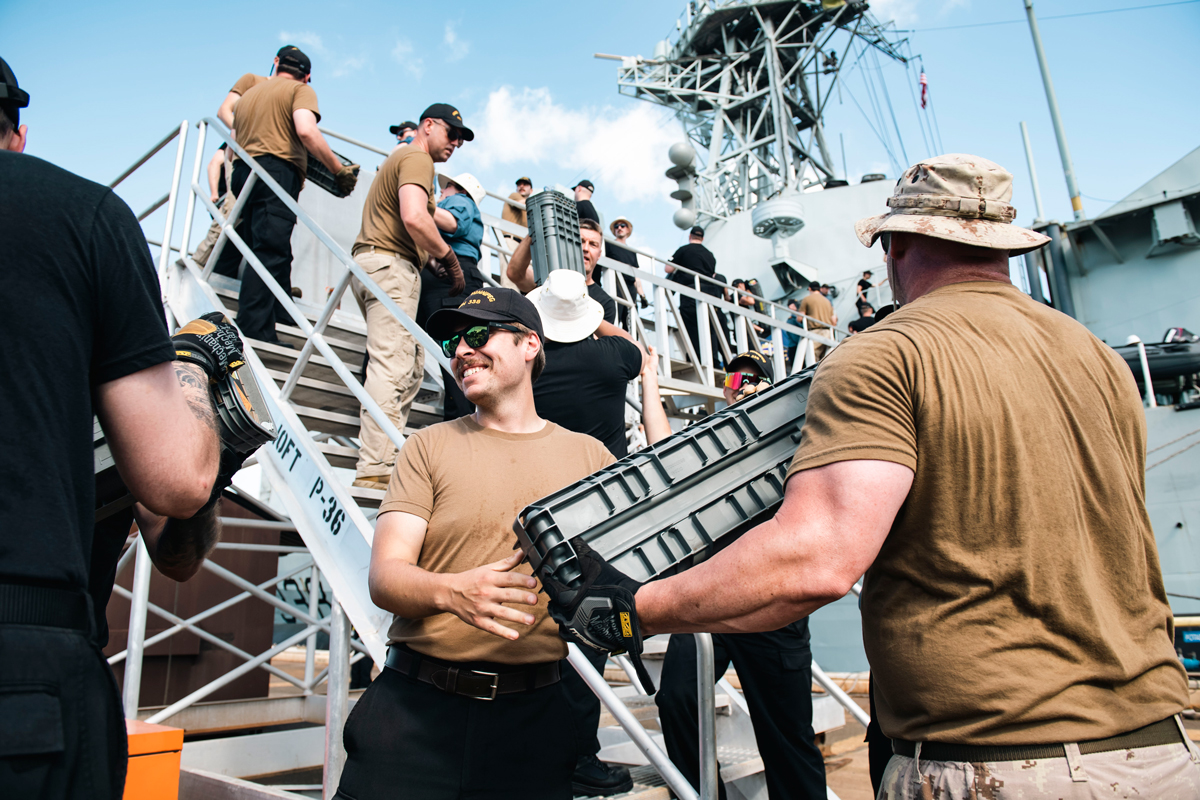Ammunition Depot conducts first forward ammunition transfer of two RCN ships
By Lookout Production on Sep 04, 2022 with Comments 0
Lt(N) Michelle Scott,
HMCS Vancouver PAO
—
Canadian Forces Ammunition Depot (CFAD) Rocky Point conducted a significant forward ammunition transfer for two Royal Canadian Navy (RCN) ships in Pearl Harbor before their follow-on deployments.
After successfully completing Exercise Rim of the Pacific 2022, which involved several gunnery exercises, HMCS Winnipeg and HMCS Vancouver restocked thousands of ammunition rounds alongside Naval Magazine Pearl Harbor (West Loch) Aug. 4-6, before deploying on Operations Projection and Neon.
Lieutenant-Commander (LCdr) Craig Newman, CFAD Rocky Point Commanding Officer, said this task differed from previous years given the significant amount of air movement.
“Ensuring both ships have the right type and quantity of ammo before they deploy is a critical element of their readiness for Force Employment,” he said, adding the team had to prepare a plan to fly a significant amount of ammo to meet the ships in Hawaii.
In previous years, CFAD Rocky Point would support rearmament with two ships alongside Hawaii. While one of the ships deployed, the remaining ship would be used to store ammunition. As this is the first year in a while that the Canadian Navy has deployed two West Coast ships on Operation Projection simultaneously, other means of transport for the ammunition had to be considered.
The ammunition was moved by road from CFAD Rocky Point to CFB Comox. From there, it took three trips for a CC177 Globemaster from 8 Wing Trenton to fly the ammunition to Hickam Air Force Base in Hawaii. Once the ammunition arrived in Pearl Harbor, it was moved to the naval magazine until it was ready to be inspected and transferred to the ships by a team of six military and civilian members from CFADs Rocky Point and Dundurn. The CFAD team prepared the ammunition for transfer and then supported the transfer to each ship under the guidance of the Formation Ammunition Inspector (FAI).
Lieutenant (Navy) Riley Monsour, HMCS Vancouver’s Combat Systems Engineering Officer, said there is a significant number of rules associated with transporting and storing ammunition.
“Every single movement has to be well-documented and confirmed in advance. Each movement requires careful oversight and compliance with the Transportation of Dangerous Goods Regulations,” Lt(N) Monsour said.
Ammunition transfers are labour-intensive evolutions for a ship’s team as all ammunition and expended rounds are carried on and off by hand, except the missiles and torpedoes, which are craned on board the ship.
Lt(N) Monsour said the transfer was a huge success.
“The American staff were very friendly and accommodating as some of our timings shifted. Certainly, we could not have executed this without the incredible ammunition team on board, not to mention the entire ship’s company who pitched in to move ammo boxes,” Lt(N) Monsour said.
In 2020, with COVID precautions and travel restrictions in effect, CFAD technicians prepared Winnipeg’s crew for conducting an ammunition transfer on their own in Hawaii.
“A significant ammunition transfer in foreign port is now a proven capability the Canadian Navy can use,” said Lt(N) Raphaël Henry, CSEO in HMCS Winnipeg. “Receiving ammunition and explosives in Pearl Harbor was a truly unique experience.”
Chief Petty Officer First Class Jon Sorensen, HMCS Vancouver Coxswain, said he enjoyed witnessing what a team of sailors, soldiers, and aviators can accomplish.
“The Hawaiian heat and thousands of rounds was no match for the collective Canadian team,” he said.
Filed Under: Top Stories
About the Author:







